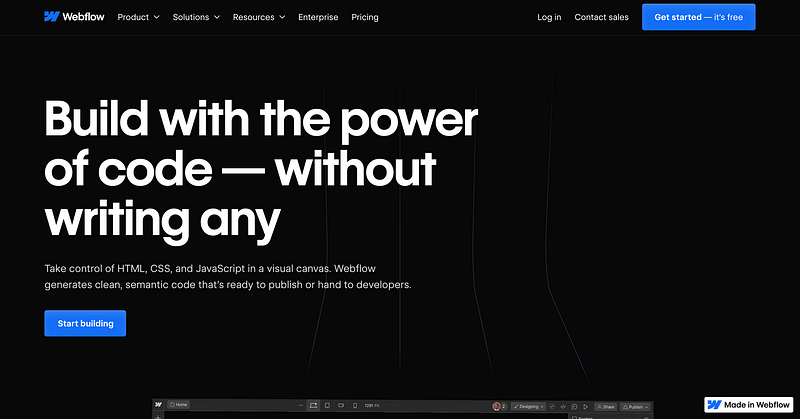Webflow vs. Squarespace: Why Webflow is the Better Choice for Agencies
You will often come across a comparison between a website builder like Webflow and Squarespace whenever agencies evaluate which one they…

You will often come across a comparison between a website builder like Webflow and Squarespace whenever agencies evaluate which one they should use. Although the two platforms both offer enhanced performance, design, and SEO capabilities, Webflow proves to be the better option for agencies for five important reasons: advanced design flexibility, SEO features, third-party integrations, pricing model, and client-centric features. Let’s run through a deeper analysis of each one.
Advanced Design Capabilities
Webflow:
Webflow also caters to professional web designers. Its interface helps power customisable designs. Without writing any real code, designers can create advanced websites with endless opportunities for customisation and, as a result, create powerful, brand-specific sites. With Webflow, designers can exert intricate controls over CSS, HTML and JavaScript, and build websites from the ground up. All of this is done directly on a visual canvas. In addition, Webflow allows for dynamic animations, responsive designs and complex user interfaces. These are all reasons why agencies tend to flock to Webflow for its potential to develop cutting-edge web experiences.
Squarespace:
Squarespace is well-known for its simplicity and user-friendly approach. It offers a lot of pre-built blocks, but the extent of the customisations is far from what Webflow offers. Agencies with any hope of crafting truly bespoke designs are going to be so restricted by Squarespace that they will feel like they are suffering under a creative dictatorship.
SEO Features
Webflow’s SEO features are quite feature-rich: you can edit meta titles, descriptions and alt text directly in the designer, and Webflow’s URL slug editor helps you build search-friendly URL structures right on the fly. When previewing your website and publishing, your code will be semantic and clean, and your website will come complete with automatic sitemaps, 301 redirects and even SSL certification. Webflow’s CMS also supports schema markup — a must for any website wishing to use advanced SEO techniques to optimise its search engine visibility.
Squarespace:
It’s all well and good, but it’s basic; there are customisable meta tags, Alt text and URLs. There’s SSL and a sitemap, but again — Webflow wins hands down, with deeper and more flexible search-engine optimisation that might be frustrating for an agency adhering to a complete SEO strategy.
Integrations
Webflow:
Webflow’s API allows for near-universal integration with third-party services, which agencies use to include dozens if not hundreds of different tools and services. Webflow integrates with Zapier and other third-party partner services, in addition to in-house features such as Shopify and Printful integrations. These elements allow users to automate workflows, creating robust e-commerce sites or well-functioning websites.
Squarespace:
Squarespace has basic integrations for social media, e-commerce and marketing that work but are more limited than Webflow. A client won’t get a website that works easily with other apps. Squarespace’s closed ecosystem makes it nearly impossible for agencies to provide integrations specific to a client or a new coding trend.
Pricing Structure
Webflow:
Scalable pricing is a bonus, too, to agencies of all sizes. There’s a free starter site and varying tiers in between. If you’re deploying multiple client sites at once, Webflow’s client billing options are a big plus, and keep prices reasonable for the agencies that use it. Site Plans and Account Plans are both available, with granular pricing so you and your clients can budget accordingly.
Squarespace:
Squarespace marks out three pricing tiers: Personal, Business, and Online Store for people building a business or selling things online. It’s priced competitively in the same ballpark as Webflow, but it cannot scale up or split projects the way Webflow does. For agencies with many clients trying to do different things, Webflow’s multi-tiered pricing and client billing offer more flexibility.
Features for Clients
Webflow:
Webflow has a user-friendly CMS (content management system) so that clients can update sections of their website without needing to learn or understand technical aspects of website development for them to make changes, all while it is still fully responsive across all devices so that the user will get a consistent experience across any device that they are visiting the site from. In the handoff aspect, Webflow allows you to set up a client handoff section where clients are given credentials as to where on the website they will have access to, as well as what portions of the website will be available for editing, all while still maintaining the ability to support them within the website that you have developed for them. Once the website has been developed and handed off to clients, it is likely that clients will want to make modifications to content or other portions of the website, specifically updating various pages with new information, such as adding new products, events, or even different descriptions of the business/company. One of the best practices outlined by Webflow is the utilisation of their Editor tool. Essentially, the Editor tool can be used to enable your clients to make content modifications or updates without running the risk of them accidentally affecting or changing the overall design of the website.
Squarespace:
And while Squarespace offers a good experience for content management and responsive design, it just doesn’t match Webflow’s level of control or client-focused features. Squarespace has templating, but it doesn’t have as much flexibility as Webflow. Sure, it offers blogging and shop features, but if you’re a serious designer, you probably already have those.
Conclusion
With its sophisticated design features, better SEO options, broader integrations and improved pricing flexibility, Webflow helps agencies deliver best-in-breed, highly customised, professionally designed websites that fulfil individual client needs.





